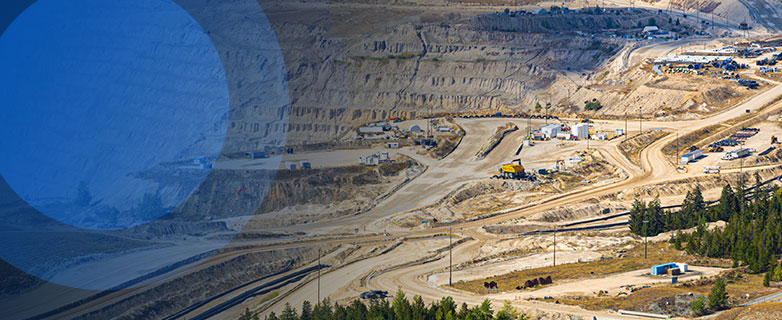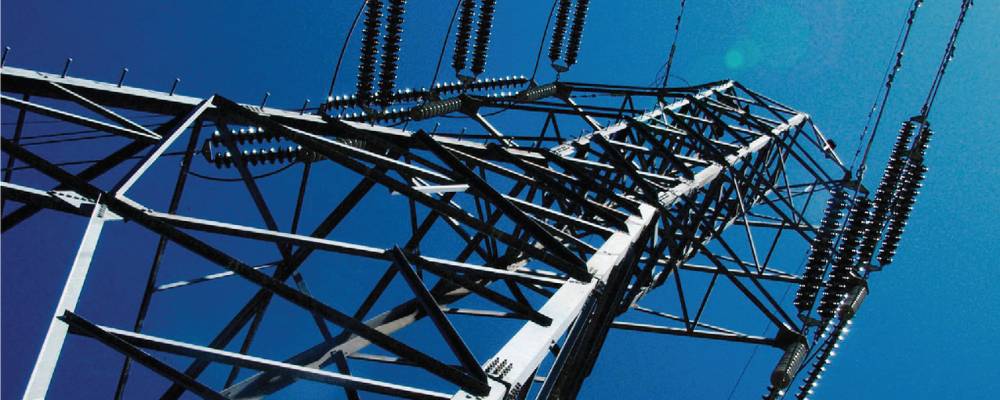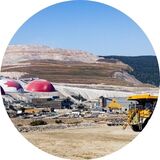Delivering major projects faster
Pillar two of the Look West Strategy focuses on speeding up permitting and delivering big projects that create good jobs.

On this page
Strategy at a glance
10-year target: Securing $200 billion in major project investment by meeting and beating permitting timelines
Building from strength
- 18 B.C. priority projects, including four critical mineral mines, 10 renewable energy projects
- Supply of critical minerals
- North Coast Transmission Line to power northern industries
- Natural gas and liquids
- Highland Valley Copper Mine Expansion
In progress
- Eskay Creek
- Red Chris Expansion
- Mt. Milligan Expansion
- BC Hydro Calls for Power
- LNG and Natural Gas projects
Goals
- By 2032 we will have:
- four new mines or expansions in operation
- three new natural gas projects
- eight new renewable energy projects operational
- Continue to build our manufacturing supply chain to serve major projects
- By 2030: 50% reduction in water and land authorizations timeline
Accelerating major job-creating projects
Vision
- Securing $200 billion in investment by 2035 for major projects in B.C.
- Advancing economic growth, creating thousands of good family-supporting jobs through streamlining permitting
- Leveraging modern technologies to streamline business processes to create simple, single points of application and tracking across regulatory agencies
- Expanding B.C.’s clean-energy capacity to drive nation-building economic growth through North Coast Transmission Line
How we're doing it
At a time of economic uncertainty, B.C. is advancing major projects that drive growth. We’re working together with First Nations, local communities, and industry to move projects forward faster, demonstrating to the world that B.C. is a reliable and stable place to invest, and creating good familysupporting jobs. The projects are real, and the jobs and benefits they bring will strengthen B.C. and Canada as a whole.
The initial group of projects expand clean-energy capacity to drive nation-building economic growth, deliver critical minerals and renewable energy the world needs, and there is more on the way.
By speeding up major projects, strengthening First Nations partnerships, and reducing our reliance on the U.S., B.C. is creating a more resilient Canadian economy and a competitive edge over other leading global economies.
Building from a strong foundation
- Over the past seven years, B.C. has benefited from thousands of construction jobs generated by the more than $100 billion in industrial projects that include the Trans Mountain Pipeline expansion, Coastal Gas Link pipeline, LNG Canada Phase 1, and Site C.
- Four of the 11 nation-building projects and a critical-minerals corridor announced by the federal government in fall 2025 are located in B.C.: LNG Canada Phase 2, Red Chris Mine Expansion, Ksi Lisims LNG Project, North Coast Transmission Line, and the Northwest Critical Minerals and Conservation Corridor.
- Among the 18 major projects, the $1.2-billion expansion of Enbridge T-North’s natural gas pipeline, the $4.6-billion Cedar LNG project, and the $500-million NEBC Connector, will strengthen B.C.’s access to markets for natural gas and generate hundreds of jobs.
Speeding up and streamlining permitting, reducing barriers and delays, and removing duplication across regulatory frameworks
Vision
- Building on the past three years of successes in speeding up and streamlining permitting — we’ve removed over 25 systemic barriers, advanced $2.795 billion in investment decisions, creating approximately 1,000 jobs
- Prioritizing the acceleration of permitting for projects of provincial significance. Of these priority projects, it is anticipated that by 2032:
- four priority mines and expansions will be in operation bringing in $4.405 billion, and 2,735 jobs
- three priority natural-gas and liquids projects will be in operation, bringing in an additional $23.014 billion and 5,450 jobs
- 10 new renewable energy projects will have received decisions and, where approved, start construction to be in operation
- By 2035, 100% of all permitting turnaround times will be met — meaning no backlogs — and B.C.’s regulatory system will be profiled as the best in the world, with predictable, timely authorizations that meet world-leading environmental standards
How we're doing it
At a time of uncertainty, it is crucial that B.C. delivers the critical infrastructure people in B.C. need, and major projects to drive economic growth faster while maintaining our high environmental standards and upholding our obligations under B.C.’s Declaration on the Rights of Indigenous Peoples Act. Unnecessary delays and hurdles can slow down projects and economic growth.
That is why we’re speeding up and streamlining permitting and regulatory frameworks to remove barriers, delays and duplications for businesses. This helps create more stability and certainty around projects, attracts investment, and creates good jobs for people.
We’re continuing to streamline existing permitting processes.
- B.C. has cleared 100% of the nearly 1,000 housing permit backlog, while improving turnaround times by nearly 15%.
- Land and water applications related to housing, connectivity, electrification priority initiatives were accelerated by 53% from an average of 322 days to 152 days to reach completion.
- The critical minerals and mining backlog was reduced by 50% overall, with some regional mining backlog reduced even more — by 52%.
- We’ve seen an overall 13% reduction in natural resources ministries application turnaround times across water, land, wildlife, contaminated sites, regional mining, forestry, and archeology permits.
We’re removing duplications where possible and combining processes, such as environmental assessment and permitting, to increase efficiency and get project decisions quicker.
In spring 2025, we passed the Renewable Energy Projects (Streamlined Permitting) Act to speed up the development of clean-energy projects in B.C. The Act designates the BC Energy Regulator (BCER) as the single window for permitting and authorizations for designated projects, including the North Coast Transmission Line (NCTL) and nine wind projects from BC Hydro’s 2024 call for power. This streamlines the process by eliminating cross-ministry and agency permitting, while ensuring environmental standards are upheld.
In addition, the Infrastructure Projects Act allows the province to approve infrastructure projects deemed essential to B.C.’s public services and economic growth, including public, private or community-led projects such as schools, hospitals, and student housing.
We’re making sure that businesses can navigate the permitting processes more easily and receive the support they need. That is why we’re implementing systemic shifts alongside leveraging modern technologies to streamline business processes to create simple, single points of application and tracking across regulatory agencies.
Working in partnership with different levels of government and communities, we’re providing greater clarity and streamlining touchpoints, while maintaining B.C.’s high environmental standards and fulfilling our responsibility to consult with First Nations. We’re also exploring opportunities to align federal and provincial processes and reduce duplications.
Faster, simpler, and better processes will make sure that global capital comes to B.C. first, generating more jobs and growth for our people in B.C. and Canada.
Building from a strong foundation
- The Highland Valley Copper Mine Expansion project received its full permits and environmental assessment certificate at the same time due to a co-operative approach and a streamlined review process. B.C. was able to efficiently issue full permits in co-ordination with the environmental assessment decision to the project, which will add 200 direct jobs, 2,900 construction jobs, and generate about $500 million in annual GDP.
- The Cariboo Gold Mine received an operating permit under the Mines Act in November 2024. An underground mine, it is expected to employ approximately 630 people during construction and see an initial investment of $137 million and another $918 million over the life of the mine. Permitting for the project was completed in 13 months. It is the first project entirely assessed under the new Environmental Assessment Act, which was developed with input from First Nations, stakeholders, other provincial agencies and the public.
- The Blackwater gold and silver mine at Vanderhoof, B.C. was permitted in less than 18 months. It is expected to generate more than $13.2 billion, including $2.3 billion in provincial revenue, over its lifetime.
Leveraging B.C.’s natural resources to deliver major projects
Vision
- B.C. will play a critical role in Canada’s Critical Minerals Strategy and we’re working to expand our critical minerals footprint across the world, and increase processing of critical minerals and new smelting projects .
- B.C. is currently ramping up LNG production. By the end of this decade, the proposed projects could add another 28.5 million tonnes of LNG per year and increase exports by adding 19.4 million tonnes per year.
- Byproducts of natural gas production (propane, butane and condensate) are also exported in Alberta and into Asian markets through two operating export terminals with the expectation that this amount will grow.
How we're doing it
We’re leveraging our abundant natural resources and creating new opportunities in industries such as mining, clean energy and forestry, working in partnership with First Nations, local communities, and businesses, to help build a more self-reliant economy.
By 2040, the global need for critical minerals will be five times more than it is today, and demand for minerals used in clean-energy technology will grow by more than 20 times. That is why we’re investing in companies like Mangrove Lithium. The company will establish a lithium-refining facility and boost battery manufacturing, while creating good jobs and contributing to Canada’s growing clean-technology ecosystem. B.C. is strategically situated with 19 of Canada's 34 critical minerals, and has port access to growing and emerging markets where critical minerals are in high demand. Unlocking these jobs through the critical minerals vision creates generational opportunities for longterm jobs and economic prosperity.
We’re working to meet this critical moment of growth by increasing our energy capacity through various renewable energy projects. Through BC Hydro’s Call for Power 2024 and 2025, we’re expecting to add 8% each to B.C.’s energy supply. BC Hydro is also launching a competitive process in early 2026 for allocation of electricity to support AI and data centres, strengthening the emerging and high-tech sectors in B.C.
To be stronger and more independent, B.C. and Canada need to be less vulnerable to supply chain disruptions and supply shocks. We also need to seize opportunities in growing sectors with highdemand now and into the future.
Building from a strong foundation
- B.C. has 33 mining development projects in progress (25 potential new mines, seven major expansions and one revitalization). Together, they could bring in $49 billion in capital investment, $16 billion to our annual GDP, $2 billion to fund key government services people rely on, and thousands of jobs. Since 2017, 4,000 new jobs have been added to the sector. About 40,000 people in B.C. are currently employed in the sector, earning an average annual salary of $138,500.
- The Site C hydroelectric project, whose six generating units are all in operation now, is increasing energy supply by 8% — or the equivalent of electricity to power 500,000 homes. Each BC Hydro Call for Power will add another 8%, and moving forward with Revelstoke Unit 6, another 5% will be added to the energy supply. BC Hydro also entered into Electricity Purchase Agreements for 10 new renewable projects resulting from 2024 Call for Power.
- Partnering with 74 forestry-product manufacturers, we’re dedicating more than $90.5 million to the industry to move collaboratively toward a stable, sustainable forestry sector in B.C. We’re supporting them to modernize, innovate and diversify their product lines and fibre sources to make more high-value, made-in-B.C. products, and help protect and create good jobs for people in B.C.
Map of Major Projects
Various projects are underway or upcoming like the BC Hydro Call for Power 2025 projects, and we are working to identify more, while ensuring consultations, permitting and environmental protection continue.

Features

Working together with First Nations
Working together, in partnership with First Nations, we are attracting more investments, creating good jobs, stability and growth, and supporting local, and often rural and remote communities, all while protecting and stewarding the lands and waters in B.C., for now and future generations.
And we have seen that in action —
- A new $200-million contribution agreement between the B.C. government and Haisla Nation will support building the infrastructure needed to make sure the Cedar LNG facility in Kitimat runs on clean B.C. energy.
- Eight of the ten successful new renewable energy projects for BC Hydro’s Call for Power 2024 have 51% equity ownership by First Nations. BC Hydro extensively engaged with First Nations on the design for 2024 and 2025 Call for Power.
- During LNG Canada’s Phase 1, the value of contracts and procurement awarded to British Columbia based businesses exceeded $5.8 billion, including more than $4.9 billion to Indigenous-owned and local area businesses. This includes a $500-million contract with HaiSea Marine — a joint venture between Haisla Nation and North Vancouverbased Seaspan (providing harbour and escort tugs).
Currently, more than 49 major investment projects involve First Nations, creating opportunities for people to build careers in high-demand sectors close to home and for communities to secure longterm benefits through business opportunities, revenue sharing and equity participation. We all share a common goal — building a B.C. that works for everyone, where people can build a good life with stable jobs and strong communities.
North Coast Transmission Line
B.C. has some of the cleanest and most affordable electricity in the world. We’re making sure we can continue to power our province into the future.
The North Coast Transmission Line (NCTL) is a transformative nation-building project that will bring clean energy to the North Coast and power economic growth, the local and First Nation communities, major projects, ports and industry, and improve access to opportunities such as education, training, and jobs for people. The NCTL will deliver 2,200 MW to the region and enable economic growth by diversifying Canada’s export market for critical minerals and metals, natural gas and other natural resources.
The project also provides the opportunity for historic co-ownership agreements that are currently being negotiated with First Nations to develop, construct, and operate certain elements of the infrastructure comprising the NCTL.
This fall we introduced legislation to make sure we can build the NCTL in partnership with First Nations and stay on track to begin construction in 2026.
As part of our ongoing collaboration with the federal government, B.C. is advocating for federal co-investment in all phases of the NCTL, a project that can also support Western Arctic defence capabilities and a future potential intertie with Yukon. On Nov. 13, 2025, the federal government announced that it has referred the North Coast Transmission Line to the Major Projects Office.
Together with First Nations, local communities, and neighbouring provinces, we can strengthen our regional energy security and leadership in sustainable energy.
First Nations Equity Financing Program
The B.C. government is working to reduce barriers and create more supports so First Nations can access capital to gain meaningful representation in projects in their traditional territories. Equity ownership in new investments will create opportunities for First Nations to work together with the Province and businesses, have a say in project design, construction and operations while creating new revenue and jobs that benefit everyone. It will help develop strong economic partnerships that build more certainty and stability for investors and local communities alike.
In Budget 2024, B.C. government announced the intent to create financing tools to support First Nations equity ownership. First Nations entities seeking equity in commercially viable investments will be considered for provincially backed equity loan guarantees in areas of shared interest. The province is finalizing the financing program design and will share more details in 2026.
Providing lowest carbon-emitting LNG
B.C.’s northeast is rich in natural-gas resources. We’re strengthening this sector and building some of the cleanest LNG facilities by implementing measures such as using clean hydroelectric power, having a strong methane regulation regime, a shorter shipping transit time, and leveraging our colder climate. We’re also building infrastructure to transport some of the lowest carbon-emitting LNG to markets – local and global.
And the LNG Sector is already driving significant investments to B.C. and providing opportunities for market diversification. In 2025, B.C. entered the global LNG market with LNG Canada at Kitimat, with its first shipments to Asia. Cedar LNG and Woodfibre LNG are currently under construction in B.C., already adding jobs and investments to the economy. Other projects, such as Ksi Lisims and Tilbury Phase 2 LNG Expansion, could further our ability to supply liquified natural gas to new markets while generating benefits at home. Ksi Lisims LNG has been recognized as one of the federal government’s nation-building major projects and has been referred to the Major Projects Office.
Additionally, we’re exploring opportunities to further export natural-gas liquids such as propane, ethane, and condensate. They have been a significant part of the B.C. economy, supported by major export terminals like the Ridley Island Propane Export Terminal (RIPET) in Prince Rupert. This capacity is expected to grow with more projects in the works.
B.C.’s Critical Minerals Corridor
Critical minerals mining development in the northwest represents a nation-building opportunity that combines economic growth, reconciliation and environmental conservation to realize tens of billions of dollars in investment and thousands of well-paying jobs to support families throughout the province.
We’re working with First Nations and the exploration sector in clearly balancing areas where critical minerals may be developed while aiming to achieve large-scale conservation of our lands and watersheds.
B.C. is uniquely positioned with port access to growing and emerging markets in Asia where critical minerals are in high demand. And we’re working to strengthen the infrastructure further. In 2025, the B.C. government approved $5 million to support Tahltan and Nisga’a purchase of the Port of Stewart, which will be central to transporting critical minerals from the northwest of B.C. to various markets.
In northwestern B.C., nine advanced mineral exploration projects, one major expansion and one revitalization are in various stages of development, and have the potential to generate $29.5-billion in capital investment, more than 8,910 construction jobs, more than 6,024 permanent jobs, plus billions in annual production value and tax revenues.
The opportunity in B.C.’s northwest is aligned with Canada’s focus on critical mineral development and connecting critical mineral projects to supply chains via a new First and Last Mile Fund (FLMF). Along with projects in Yukon and Alberta, this is an unparalleled opportunity to drive Canada’s economic security in the face of economic threats.



